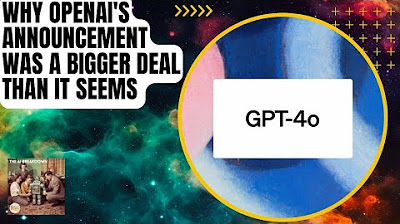O film gerçek oluyor: Yeni GPT-4o yapay zeka modelinin sesine inanamayacaksınız!
Summary
TLDROpenAI has unveiled a groundbreaking update to ChatGPT, introducing GPT-4o, a model that signifies a leap in human-machine interaction. Unlike its predecessors, GPT-4o is capable of processing audio, video, and text in near real-time, engaging in natural conversations that blur the line between human and artificial intelligence. The 'o' in GPT-4o stands for 'Omni,' reflecting its multi-modal capabilities. Demonstrations show GPT-4o's ability to understand and respond to emotional cues, participate in interactive games, and even engage in multi-AI conversations. It can also translate languages in real-time with impressive speed, nearing human reaction times. The model's advanced voice modulation and use of humor and personality make it more than an assistant; it's a companion that can sing, tell jokes, and even perform in a duet with another AI. The technology's potential applications are vast, from educational aids to real-time assistance for the visually impaired. The script also highlights the competitive landscape in AI, with companies like Google and Meta racing to integrate these advancements into their products. As AI continues to evolve, it's poised to transform our interactions, making them more personal and emotionally resonant.
Takeaways
- 🚀 OpenAI has introduced a groundbreaking update with GPT-4o, a model that can process audio, video, and text in real time and interact naturally with humans.
- 🔠 The 'o' in GPT-4o stands for 'Omni', signifying its comprehensive capabilities, and it is a nod to the movie 'Her', which was translated as 'Aşk' (Love) in Turkey.
- 🗣️ GPT-4o can converse with users not just through text but also through voice, adding emotional nuances to its responses, making it more human-like.
- 📹 It can see through a camera and react to visual stimuli, such as a dog on a video call, which enhances the illusion of a real interaction.
- 🤖 The model can handle interruptions and direct commands during conversations, showcasing improved AI responsiveness and understanding.
- 🕺 It can also mimic human behavior, such as stammering or laughing, which adds to the realism of the interaction.
- 🎲 GPT-4o can engage in interactive activities like games, demonstrating its ability to process and respond to real-time visual cues.
- 🌐 The AI can perform real-time translations between different languages, showcasing its multi-modal capabilities.
- 🚀 Its response time has been significantly reduced to an average of 320 milliseconds, which is close to human reaction times.
- 🎤 GPT-4o exhibits mastery in voice modulation, including speed and tone, and can even sing songs like 'Happy Birthday'.
- 🤝 It can interact with other AIs, describing environments and events, and even engage in collaborative activities like song performances.
Q & A
What is the name of the new model introduced by OpenAI?
-The new model introduced by OpenAI is named GPT-4o.
What does the 'o' in GPT-4o stand for?
-The 'o' in GPT-4o stands for 'Omni,' which is a Latin prefix meaning 'all' or 'every.'
How does GPT-4o differ from previous versions of ChatGPT?
-GPT-4o differs from previous versions by using audio, video, and text information in almost real time, allowing for natural and emotional interactions.
What is the significance of GPT-4o's ability to use a camera?
-GPT-4o's ability to use a camera allows it to see and interpret visual information, enhancing its interaction capabilities by providing more context and understanding.
How fast can GPT-4o respond to voice inputs?
-GPT-4o can respond to voice inputs at speeds up to 232 milliseconds, with an average of 320 milliseconds, which is very close to human reaction time.
What notable feature of GPT-4o was demonstrated with a job interview scenario?
-In the job interview scenario, GPT-4o demonstrated its ability to give personalized feedback and advice based on visual information, such as suggesting the user tidy their hair.
How does GPT-4o enhance the realism and quality of dialogue?
-GPT-4o enhances the realism and quality of dialogue by allowing interruptions, responding naturally, and incorporating emotional nuances and humor in its responses.
What was the significance of the demonstration involving two people and a game?
-The demonstration showed GPT-4o's ability to monitor real-time interactions, such as hand movements, and respond dynamically, even making jokes and using participants' names.
What applications are suggested for GPT-4o's capabilities?
-Suggested applications include educational aids, call center support, assistance for the visually impaired, and as a tourist guide providing real-time information.
What competitive developments are mentioned in the video regarding other companies?
-The video mentions competition from Meta's Llama 3, Samsung's collaboration with Google on Galaxy S24 phones, and potential collaboration between Apple and OpenAI.
How does GPT-4o compare to the AI depicted in the movie 'Her'?
-GPT-4o is compared to the AI 'Samantha' from the movie 'Her' due to its natural and emotional interaction style, which makes it feel more like a friend than just an assistant.
Outlines

This section is available to paid users only. Please upgrade to access this part.
Upgrade NowMindmap

This section is available to paid users only. Please upgrade to access this part.
Upgrade NowKeywords

This section is available to paid users only. Please upgrade to access this part.
Upgrade NowHighlights

This section is available to paid users only. Please upgrade to access this part.
Upgrade NowTranscripts

This section is available to paid users only. Please upgrade to access this part.
Upgrade NowBrowse More Related Video
5.0 / 5 (0 votes)





